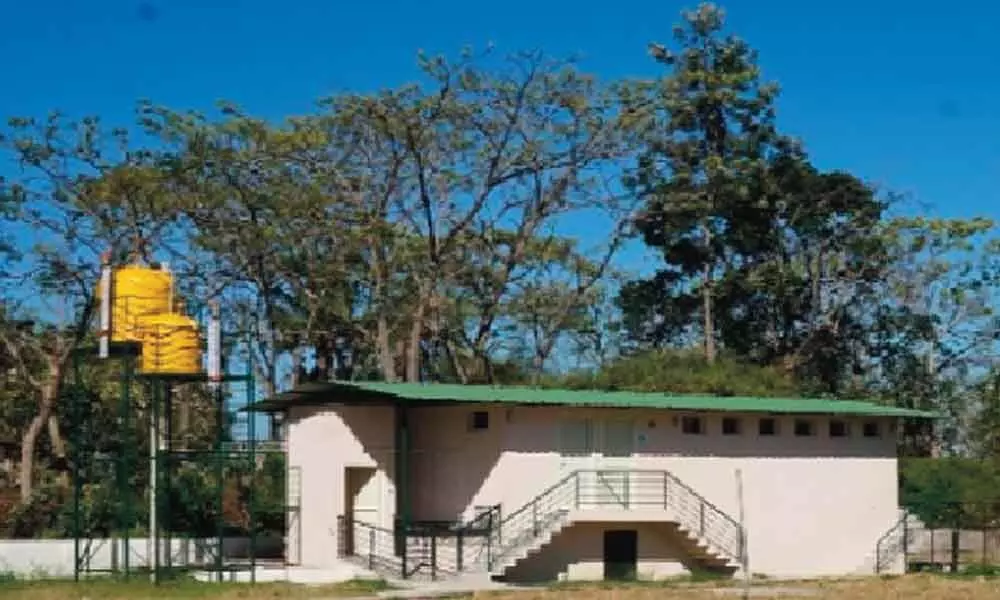Live
- Chanchalguda Jail Officials Say They Haven't Received Bail Papers Yet, Allu Arjun May Stay in Jail Tonight
- BJP leaders present evidence of illegal voters in Delhi, urge EC for swift action
- Exams will not be cancelled: BPSC chairman
- Nagesh Trophy: Karnataka, T.N win in Group A; Bihar, Rajasthan triumph in Group B
- YS Jagan condemns the arrest of Allu Arjun
- Economic and digital corridors to maritime connectivity, India and Italy building vision for future, says Italian Ambassador
- SMAT 2024: Patidar's heroics guide Madhya Pradesh to final after 13 years
- CCPA issues notices to 17 entities for violating direct selling rules
- Mamata expresses satisfaction over speedy conviction in minor girl rape-murder case
- Transparent Survey Process for Indiramma Housing Scheme Directed by District Collector
Just In
IISc researchers develop decentralized wastewater treatment system in school


IISc researchers develop decentralized wastewater treatment system in school
Researchers at the Centre for Sustainable Technologies, Indian Institute of Science (IISc) have developed an efficient decentralised wastewater treatment and recycling system at the Primary School in the remote village of Berambadi in Karnataka.
Bengaluru: Researchers at the Centre for Sustainable Technologies, Indian Institute of Science (IISc) have developed an efficient decentralised wastewater treatment and recycling system at the Primary School in the remote village of Berambadi in Karnataka.
The study, published in the Journal of Water Process Engineering and carried out in collaboration with researchers in the UK, shows how the system has, over the past year, enabled the reuse of wastewater and reduced dependence on freshwater resources. "We have demonstrated for the first time that decentralised wastewater treatment systems can be economically put into practice in a rural setting," says Lakshminarayana Rao, Assistant Professor at CST and a senior author of the paper.
The research team operated the greywater treatment system for a year and monitored the different physicochemical and biological characteristics of the greywater at the entry and exit points. The performance of every treatment stage was quantified in terms of removal efficiencies (REs) of turbidity, Total Suspended Solids (TSS), nitrate, total phosphorus, Biological Oxygen Demand (BOD), Chemical Oxygen Demand (COD) and faecal coliforms (FC). Overall, the system showed high REs – more than 90% for most of the parameters. About 667 litres of greywater was treated daily using the system, saving around 180,000 litres of water annually.
Purified water is being made available for washing hands and cleaning purposes in the kitchen during lunch hours. The treatment system first passes the greywater from the hand wash sinks through strainers that screen out large food particles from water. "Then, the water goes through three anaerobic sand bio-filters – tanks filled with locally available coarse gravel, medium gravel and sand, where bacterial biofilms help in the breakdown of nutrients in greywater to reduce nutrient levels of water," explains PS Ganesh Subramanian, a former Project Assistant at CST and the first author of the paper.
The greywater from the kitchen sinks, on the other hand, is first passed through a grease trap to strip off the top layer of oil and grease from water. After this, water flows through an anaerobic sludge bioreactor followed by a stratified biofiltration chamber. Finally, the filtered water from both hand wash sinks and kitchen sinks enters an aeration tank followed by an ozonation tank, where it is treated with ozone for disinfection. The ozone is generated using a cold plasma ozonator designed specifically for disinfection of wastewater. "Ozonation removes odours and colours from water, and eliminates FC, thereby disinfecting the water while leaving no harmful by-products. It also enhances the Dissolved Oxygen (DO) concentration of the water," explains Subramanian. The treated water stored in an overhead tank is then readily available for reuse by the students and staff of the school for domestic non-potable purposes such as toilet flushing and gardening.
"Here, plasma technology is used to create a high throughput solar powered ozonator for cleaning up the water effectively," says Rao. The ozonator used in the system works with ambient air as the input gas – instead of oxygen – to generate ozone. "This completely eliminates the need for hazardous oxygen cylinders, thus allowing the system to be easily operated and maintained by the staff at the school," he says.
"Such a robust wastewater management system can be replicated in both rural and urban settings after taking into consideration various factors such as space limitations, baseline greywater quality and daily flowrates, the authors suggest. "The people from Berambadi village are very happy with the system. Based on the success of this sustainable wastewater management project, several other schools in Karnataka have approached us to duplicate it in their schools," says Rao.

© 2024 Hyderabad Media House Limited/The Hans India. All rights reserved. Powered by hocalwire.com






